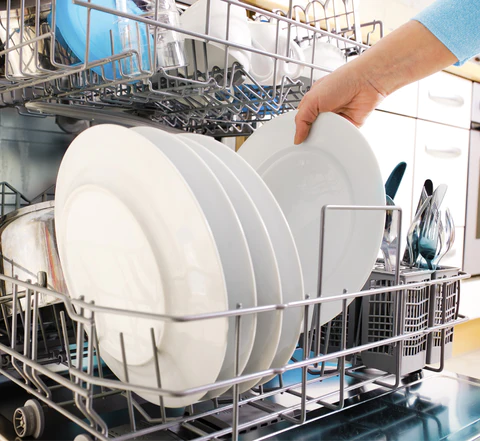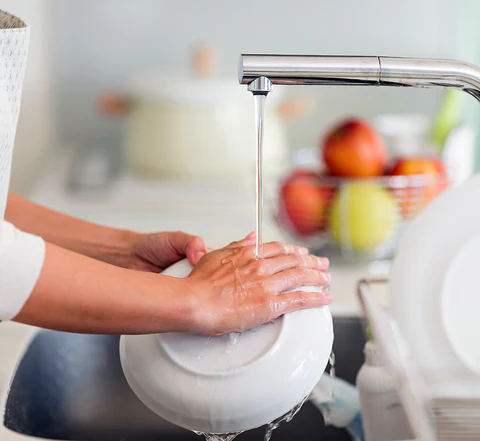Is It Better To Use The Dishwasher Or Hand-Wash Your Dishes?
We’ll start with this: There is most definitely a wrong way to wash dishes, and chances are, you’re guilty of it. Generally, people are not efficient dish washers. If you let the hot water run, sending it past the dishes and down the drain, that’s certainly the wrong way. Measured against that kind of water-wasting hand washing, your dishwasher will usually be the more environmentally-friendly option.
However, that whole notion goes out the window if you’re a habitual pre-rinser of dishes. If you pre-rinse, then put them in the dishwasher, and have to put them through again when that casserole dish comes out of the dishwasher still crusted with baked-on eggs and cheese, then the efficiency level of machine-washing can significantly plummet. Note: Dairy, eggs, and oils are notoriously tough to wash away in the dishwasher.

Dishwashers
Dishwashers are one of our favorite inventions—most of us would openly admit that it would be hard to live without our dishwashers. These appliances make one of the most tedious tasks for the home less stressful and more convenient. But dishwashers come with problems of their own and it’s crucial to use them properly, not just for the sake of getting dishes as clean as possible, but also to keep your dishwasher working for as long as possible.
You have to use it right or it could cost you time, money, and energy.
Pre-Rinsing Dishes
Pre-rinsing can be a hard habit to break, but it turns out, you aren’t supposed to pre-rinse your dishes after all. According to the manufacturer’s instructions on modern dishwashers, dishes shouldn’t be rinsed before being loaded. Efficient machines, combined with good dishwasher detergent, actually work better with a bit of grease. However, this doesn’t mean you should just put dinner plates straight from the table, directly into the dishwasher. It’s crucial to remove excess food scraps or sauces: You should do a quick wipe to get off loose food.
But, skip the sink. Save time, water, and energy, and just pop those coffee cups straight into the dishwasher.
Washing Things in the Dishwasher that You Shouldn’t
Not everything is designed to be cleaned in the dishwasher. Plastic, melamine, fine china, and crystal usually aren’t dishwasher-safe. While your dishwasher might have a china or delicate setting, it can still be risky. So, check the bottoms of your plates and cups for directions. If you’re still not sure, err on the side of caution and hand-wash.
Related: 10 Things You Probably Didn’t Know You Can Clean in Your Dishwasher
Loading Dishes the Wrong Way
Technically, there isn’t a right or wrong answer here, because the best way to load the dishes can also depend on how a dishwasher’s rack is designed. But having a system for loading dishes can save time and energy. For example, loading glasses from back to front so you can quickly see if there’s room to fit that one last mug in. We also suggest loading larger dishes, like dinner and salad plates, toward you. This gives the sprayer plenty of room to work, which can be compromised when the dishwasher is overcrowded with randomly placed and stacked dishes.
Having a system also makes the unloading process a less arduous task. An organized dishwasher makes unloading the dishes easier! When all of the like items are grouped together when loading, unloading and putting away is quick.
Using the Wrong Rack
If you’re not sure where to place things in the dishwasher, especially plastic, flip it over and see if there are manufacturer’s instructions. If there are no instructions, generally, plastic food storage containers, glasses, mugs, small bowls, and top-rack-safe-only items go on top. We also recommend using the top rack for long serving pieces and knives. Plates, large bowls, and casserole dishes should go on the bottom rack.
Inserting Utensils Incorrectly in the Utensil Basket
Handles up or handles down? Turns out, this is largely based on personal preference, but there are some rules of thumb to follow. This is pretty definitive for homes with children or where the little ones help out by unloading the dishwasher. After all, you don’t want them to grab onto knife blades or fork prongs and get injured. We will also note that pointing your items down—with their handles up—is the more hygienic method. You won’t handle the part of your spoons and forks that will eventually go in someone’s mouth. The only downside of this approach? The more utensils you pile into the flatware holder in your dishwasher, the more crowded the space will be. Best washing results are obtained when the silverware is mixed and evenly distributed, not nested together. Don’t group cutlery of the same type together. Separating silverware so that forks, knives, and spoons are mixed and evenly distributed allows the water to pass through each utensil more easily, resulting in a cleaner result.
If your dishwasher has a separate utensil rack, use the designated slots in your machine’s to prevent forks, knives, and spoons from sticking together; this will also keep them free of any water marks. And while rusting is uncommon, actively ward it off it by adding any silver-plated silverware and stainless-steel cutlery to separate compartments. When different metals are placed next to each other, contact corrosion can happen, which can cause metals to rust.
Using Too Much Detergent
Tempted to add some extra detergent in the tray? This actually won’t get your dishes any cleaner. In fact, residue from excess dish soap can leave your dishes gritty. Even worse, too much soap can cause the suds to overflow some machines. This can potentially lead to expensive repairs. So, avoid temptation and opt for a pre-measured pack, or just be sure to stay under that maximum fill line when loading your dish detergent gel.
Failing to Clean and Maintain the Dishwasher
Like any other appliance, properly maintaining a dishwasher is essential. If your dishwasher has a filter, it’s important to clean it regularly. You should also keep your eyes out for things like seeds or food scraps that didn’t get scraped away at the bottom of the dishwasher and remove them as soon as possible.
Related: Dishwasher, Meet Vinegar.

Hand Washing
Hand-washing your dishes the correct way, you might come out slightly ahead of the energy-expenditure game—only because you’re using human energy to dry the dishes rather than the heat cycle on your dishwasher.
That said, there is one definitive reason for picking up a sponge: The dishwasher wasn’t designed to wash every single item in your kitchen. In fact, you could ruin certain kitchen tools by running them through it. We’ve made a list of items you should never put in the dishwasher—not even on the rinse cycle.
- Kitchen Knives
- Certain Plastic Items
- Nonstick, Copper and Aluminum Cookware
- Fine China and Crystal
- Wooden Kitchenware (Including Cutting Boards)
- Anything Cast Iron
- Insulated mugs and containers.
- Silver
- Hand-painted ceramics and stoneware
- Acrylic dishware
- Pressure cooker lids
- Gold-colored flatware
And if you live alone and you have a rotation of the same three to four dishes each day, using a dishwasher might not even make sense – unless you don’t mind using it sporadically.
How-to for the greenest-possible hand-washing?
Fill half of a split sink with hot water (“as hot as your hands can stand”) and a small amount of plant-based dish soap; fill the other side of the sink with clean hot water. Scrub dishes on the soapy side, then rinse them on the clean side. Avoid letting the water run as you’re washing, if possible. Wash the glassware first. Then move to plates and silverware. Finish with pots and pans. Dry with dish towels, not paper towels (remember: the goal is green), or let air dry in a drying rack.
By using this hand-washing technique, you’re likely using the same amount of water as a typical Energy Star dishwasher does, around 4 gallons. The differences we’re talking about are pretty marginal.
You can also opt to hand wash dishes using foaming dish spray. Dish soap spray quickly dissolves stuck on and baked on messes. The spray-activated foam instantly cuts grease on contact (no water needed), working faster than regular dish soap. It’s convenient and easy to use – simply spray onto dishes, pots and pans, wipe and then rinse away.
Sanitation Standoff
The dishwasher does in fact clean the dishes “more”. Dishwashing is very effective in sanitizing dishes and other household items. It achieves optimal removal of soiling and bacterial matter through a combination of temperature, water distribution, and time — something that’s not possible with hand-washing. Basically, the water inside most of our machines gets hotter than the water from our tap, offering a better chance at killing germs.
The Environmental Arena
A dishwasher—especially a high-performing water-efficient, energy-efficient dishwasher—is going to be the way to go for most people. It’s really hard to beat the efficiency of a dishwasher. A modern dishwasher uses somewhere between a gallon and a half to five gallons per cycle. Washing dishes by hand (if you leave the faucet running) sends more than two gallons of water down the drain per minute.
Analysis out of UCLA also shows that dishwashers generate fewer greenhouse gas emissions. The additional water distribution and energy required to heat the water for hand-washing is just a little bit harder on the environment.
But don’t worry, you’re not going to single-handedly ruin the environment or anything by using the tap. Just follow the best practices we outlined above.
